Author : Pierre Fabre
Sol 3: Focus on: Water on Mars – How do we manage water on Mars?
Sometimes on Mars you have to improvise and those first days were a good example of that statement.
Two days ago an EVA which aimed to map the North Ridge area didn’t go as planned. We had to come back to the station because a member lost his visibility because his bandana fell on his eyes (in fact it was me). This can be seen as funny but when you are on an EVA on Mars it’s not funny at all because there is no way of pulling it back on your forehead due to the spacesuit. This issue made us lose precious time and then we didn’t have enough time to map the area properly with the drone.
Due to this first issue, we had to reschedule an EVA to this morning to make a second attempt of mapping North Ridge. We really needed that map for an experiment so we had no other choice. (I will talk to you about this cool experiment in another report don’t worry)
But yesterday when we were making the EVA request, we discovered that this morning was really cold and windy. Those conditions could have jeopardise the success of the drone mapping. With this new information in mind, we decided to reschedule the EVA to this afternoon when the weather was definitely better suited for flying drones. Finally, we managed to do the EVA this afternoon and we successfully mapped the North Ridge area with the drone. On Mars, you need to be flexible and adapt to every new situation you encounter.
3D printing is good when you need to adapt like in a Martian environment. On Mars, you would not have every tool you need and it is not an option to wait for somebody to send it to you. Sometimes you have to make your own tools and 3D print them is, I think, a good option. For example, Julie needed a custom-made funnel to filter used water and recycle it, so Maxime and Clément designed and printed it, which is very convenient. Well, they nearly printed it, but on instead they spent the afternoon trying to make the 3D printer work, but you have the idea!
Talking about recycling water, today we are going to talk with some members of the crew about the management of water in the station. This is the first episode of our new format of report called « Focus on » in which we are going to focus in each episode on one or a set of experiments. I hope you’ll enjoy it!
« Pierre: Ok so first why it is so important to manage water properly on Mars?
Clément: well, I think the answer is pretty obvious: Mars is a very dry desert almost all over, a lot more than here even! So if we are ever to go there, we need to bring with us the water we’ll drink, and conserve it as much as possible because there’s little to no way to resupply if we ever run out.
Pierre: What are the most water consuming activities in the station?
Clément: the biggest one is actually watering the plants in the GreenHab! Unlike us, there’s no restricting how much they use water. On the human side, it’s practically all hygiene related. Even if we try to limit showers and other things, keeping the station and ourselves clean enough still takes a lot of water.
Pierre: How to save water?
Julie: First, before you recycle water, you need to save it up, because the whole recycling process is very long and does not provide us with drinkable water. To save it up, we need to be more careful when we are using it : we wash our hands with sanitizer most of the time, we use wipes when we feel dirty, we do not put water on our toothbrush before brushing our teeth, we only take one or two showers a week, and we need to be strategic when washing dishes. Our priority is the water that we drink, and water for the GreenHab. For our safety, we can’t have any restriction on any of these two.
Used water we store it in barrels in an organised way. Then, how do we treat it ? Actually, soap molecules react with dirt, to trap it, creating soap-dirt complexes. To extract these complexes from water, we make them react with calicum ions which react very well with the soap molecules part that is not in direct contact with dirt. The final white product formed by this reaction contains the calcium, the used soap, and the dirt, and has moreover the great quality to be solid ! It makes it easy to extract from water : We just need to filter it whith some filter papers, an adapted funnel and a container. We obtain completely clean water, that we just need to warm in order to kill most of the leftover bacteria before using it again ! However this method works perfectly only with the most basic soap : Marseille’s soap, which can be separated very easily from water with calcium, as opposed to other kinds of soaps. As a consequence, it’s been 3 days that the crew is exclusively using Marseille’s soap in the station.
Pierre: How to monitor the quality of the water we drink?
Marion: Just as it is done on the ISS, we will need to test the quality of water on Mars to ensure that it is safe to drink. Thanks to the French Space Agency, CNES, and Biomerieux, we are able to use Aquapads. These small boxes host a medium which allow for bacterial growth. After injecting some water directly from our tap inside the Aquapad, we put it in an incubation tank for 48-72h. When we take it out, we can count the amount of bacterial colonies on the pad. The total can be compared to empirical values that allow us to draw conclusions as to whether the water is safe to drink. The Aquapad is very effective as its small (4cm in diameter) size makes it easy to bring on space missions. »


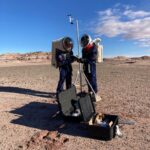
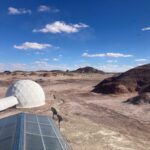

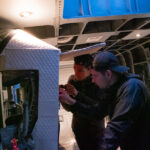



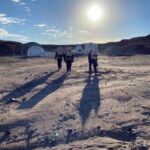
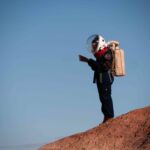
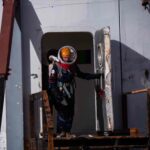
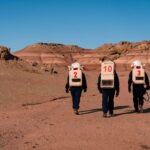
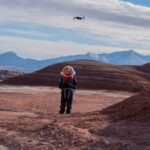
You must be logged in to post a comment.